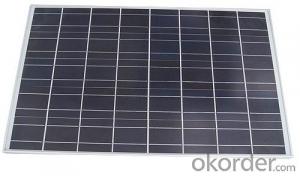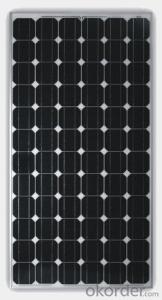Solar Modules (Mono crystal )TDB125×125-96-P
- Loading Port:
- Ningbo
- Payment Terms:
- TT OR LC
- Min Order Qty:
- 100 carton
- Supply Capability:
- 10000 carton/month
OKorder Service Pledge
OKorder Financial Service
You Might Also Like
Specification:
· Highest performance enabled by higher efficiency monocrystal line cells and the latest Solar Wafer Technology for multicrystal line cells
· Lower weight design which reduces the total system load on a roof, making it ideal for residential customers. Its shape allows for better roof utilization
· Its low weight means easier handling for installers
· Modules are designed to withstand PID (Potential Induced Degradation)*
· High light transmission Anti-Reflective Glass with improved self-cleaning capability
· 0/+5 W Positive power tolerance for reliable power output
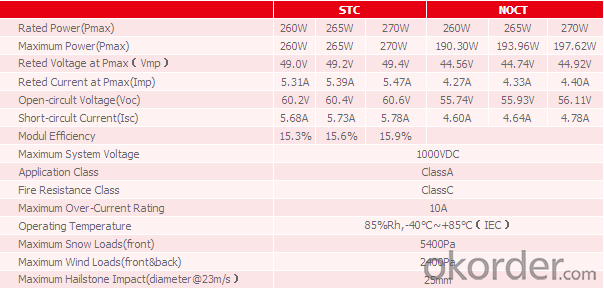
Warranty
CNBM Solar provides one of the most comprehensive module warranties in the industry:
· 10 years for product defects in materials and workmanship
· First 12 years for 90% of warranted minimum power
· Remaining 25 years for 80% of warranted minimum power
Certification
CNBM Solar strictly carries out the ISO 9001 quality control methodology and has implemented check points at every step of the production process to ensure our product performance durability and safety. The stringent quality control process has been confirmed by numerous independent agencies and LDK Solar modules earned IEC, TUV and UL certifications.
· IEC:IEC 61215, IEC 61730 (1&2), conformity to CE
· UL 1703 2002/03/15 Ed:3 Rev:2004/06/30
· ULC/ORD-C1703-01 Second Edition 2001/01/01
· UL and Canadian Standard for Safety Flat-Plate
· ISO 9001: 2008 Quality Management Systems
· CEC Listed: Modules are eligible for California Rebates
· PV Cycle: Voluntary module take back and recycling program
· MCS Certificate

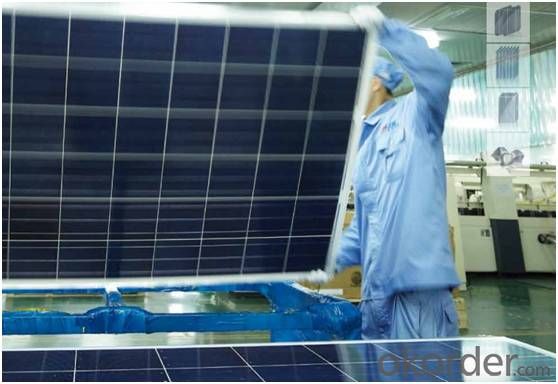
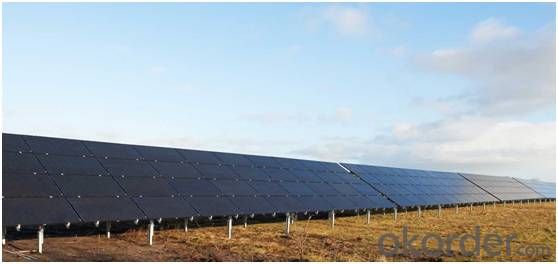
FAQ
1. How do I decide which system is right for me ?
For protection from long outages, include a generator or solar panels in your Must solar system. Shorter outages can be handled by a battery-only system.
2. Where my system will be installed ?
Must solar systems are usually wall-mounted near a home's main electrical (circuit breaker) panel.
3. How do I install my system ?
A must solar backup inverter is connected to a home electric system , we will supply detailed installation manual and videos for our customers .
How fast will my system respond to a power outage ?
Must solar inverters typically transfer to battery power in less than 16 milliseconds (less than 1/50th of a second).
What kind of batteries do the systems include ?
Must solar backup electric systems use special high-quality electric storage batteries.
- Q:I have to show in a project (a model house) how Solar Panels work. In my model I want to show Solar Panels creating electricity to power a T.V but I need to show how the power gets from the Solar Panels to the T.V. A diagram would be really helpful. Please try and make this as simple as possible as I'm only 3, but try and be specific as well!
- How photograph voltaic Cells artwork by applying Scott Aldous interior this text a million. creation to How photograph voltaic Cells artwork 2. Photovoltaic Cells: changing Photons to Electrons 3. How Silicon Makes a photo voltaic cellular 4. Anatomy of a photo voltaic cellular 5. capability Loss in a photo voltaic cellular 6. photograph voltaic-powering a house 7. fixing photograph voltaic-capability themes 8. photograph voltaic-capability execs and Cons 9. lots extra counsel 0. See all actual technological know-how articles you have in all probability seen calculators that have photograph voltaic cells -- calculators that on no account want batteries, and at times do no longer even have an off button. as long as you have adequate gentle, they seem to artwork perpetually. you have seen bigger photograph voltaic panels -- on emergency street signs and indications or call boxes, on buoys, even in parking lots to capability lighting fixtures fixtures. besides the undeniable fact that those bigger panels are not as elementary as photograph voltaic powered calculators, they're available, and not that problematic to discover in case you realize the place to look. There are photograph voltaic cellular arrays on satellites, the place they're used to capability the electrical powered structures. you have in all probability additionally been listening to appropriate to the photograph voltaic revolution for the final twenty years -- the concept sooner or later we can all use loose electrical energy from the solar. this is a seductive promise: On a superb, sunny day, the solar shines approximately a million,000 watts of capability in line with sq. meter of the planet's floor, and if shall we convey mutually all of that capability shall we quite capability our residences and places of work for loose.
- Q:I live in a higher LATITUDE so in the winter months, there is a limitation in the amount of sunlight available, but will this impediment restrict the ability of solar panels to function due to the lack of sunlight involved?
- Solar panels work in sunlight, so obviously the more sunlight, the more power. However, ironically, solar panels don't like heat, so they work better in the cold. Higher altitudes often have more sunlight, due to less crud in the atmosphere, and are often colder than lower altitudes, so you will often get better performance in higher locations. We have solar systems working in every continent in the world, including near both the north and south pole.
- Q:Can solar panels be installed on a greenhouse?
- Yes, solar panels can be installed on a greenhouse. In fact, it is a popular practice to install solar panels on greenhouses as it allows for sustainable energy production while utilizing the available rooftop space. The solar panels can help power the greenhouse's electrical systems, such as ventilation, lighting, and irrigation, reducing reliance on external energy sources. Additionally, the panels can provide shade and protection to the greenhouse, helping to regulate temperature and improve overall energy efficiency.
- Q:What would it take to make a heater for a small solar panel. I am looking into making a heater for a livestock tank to keep ice melted. I know that heaters take alot of energy to run, but my theory is that if heated mirrors on a car can melt ice with low voltage and im sure not extreme heat (40-60 degrees) then making a heater with just high enough temperature to keep from icing over and melting ice is possible. Where do I start? I would like to use an inexpensive solar panel that will generate enough heat to keep ice from forming and melt it at the beginning of the day. How can you make such a heater and apply Ohms law so that it will function correctly, what Wattage will the pannel need to produce to generate enough heat for the heater. The device will only have to be large enough to melt a spot large enough for an animal to drink.
- Absolutely. But I see your point about the Ohms law. I think you'd need technical schematics to get the raw details.
- Q:Can solar panels be used to power a military base?
- Yes, solar panels can be used to power a military base. By harnessing solar energy, military bases can reduce their dependency on traditional energy sources and enhance their operational capabilities. Solar panels can provide a reliable and sustainable source of electricity to power various facilities and equipment in a military base, contributing to energy independence and environmental sustainability.
- Q:I have a 2 volt deep cylce Everstart battery with 845 cranking amps, and a Grape Solar GS-S-250-Fab5 250-Watt Monocrystalline Solar Panel . I use them to power a 48Flat screen TV, a Roku, my 65 watt consuming MacBook Pro, and a 65 watt Fan.I know from previous experience that just the battery, an inverter, and the fan, that the fan will blow for 0 hours straight.Should I really be concerned with a Charge Controller?
- Should I really be concerned with a Charge Controller? Yes. The main purpose of the charge controller is to protect the battery from over charging. Over charging reduces battery life. And spending extra money for a MPPT type controller will get more more useable power out of your solar panel. Would another battery of the same magnitude be helpful in preventing an accident? How much storage capacity does your current battery have (measured in kWH)? A ~$20 Kill-a-Watt meter would take a lot of uncertainty out of how much power you actually use. Even deep cycle batteries suffer reduced battery life from deep discharges. The battery sounds too small for the loads you describe so I would think you would want more. ---------------------------------------... After reading the other answer In a nutshell, with your small 2 volt starting battery, 24 volt panel and a mix of unknown loads, (which is correct), I thought I would elaborate. I had not considered the possibility that you bought a 24 volt panel for your 2 volt battery. Hooking the panel you bought directly to the current battery is a horrible idea. I you were lucky it would just cook the battery in a short period of time. You basically bought the wrong type of panel for a 2 volt system. I assume that there are no controllers on the the market for this situation. If that's the case, I don't know of any good way match the 24v panel to the 2 volt battery.
- Q:I am starting to think about solar panels as an option for my home. I have done some research on panels, to be honest its all very confusing. There are many different panels some with 60 watts some all the way up to 20 watts. My household currently uses about 2700 to 3400 kWh every two months. So based off of my power usage maybe you can answer some of the following questions:What kind of panels should I be looking at?Which panel manufacturers give the best bang for the buck (reliable/affordable)?Anything else I should be concerned about?I am just starting out in educating myself on solar power so please excuse me if I sound very naive. Any information that you may have will be helpful. Thanks in advance.
- I'm not an expert, but I recently went through the process and now have a system on my home. I got 3 quotes from 3 licensed contractors and they all seemed to be about the same, the prices seemed to be based on the amount of energy they produced. In CA and I'm sure everywhere else they are tested by an independent agency which rates the output of the panels. You seem to have similar usage as my house, I got a 3.75kwhdc unit, it isn't expected to eliminate my bill, but it should reduce it by quite a bit. I've only had it for a few months and it took me from about 45 kwh per day to around 0. I know I'll have lower output in the winter, but my usage is lower in the winter as well. I decided on this size unit to maximize my rebates and I can take advantage of my utilities rebates when I add to the system in a few years. The difference between panels seemed to be how big they were. Some systems can be twice the size and produce the same amount of energy. I put a couple links below that I found helpful. The roseville pv buy down program has some great links that give information about specific systems.
- Q:Do solar panels require batteries?
- No, solar panels do not require batteries. They generate electricity directly from sunlight and can be connected to the electrical grid to supply power or utilize net metering to offset energy consumption. However, batteries can be used to store excess energy for later use when solar generation is low or during power outages.
- Q:If I wanted to add solar panels to my home to produce on average, 8 kWh of electricity daily, how much do you estimate it would cost using state of the art technology?I live in Virginia (Washington DC Metro Area), and I have Dominion Power. I pay the following electric rates:Jun-Sep $0.0904/kWhOct-May $0.0776/kWhAnnual Ave: $0.0824/kWhDistribution charges add on approximately another $0.0228/kWh.How long would the ROI for an 8 kWh/day solar system be?
- Figure 8 hours of sun per day, so 8 kW-hr is a rate of kW, which is a medium sized panel, probably not enough to operate your house totally, unless you have a very small unit. Averaged over 24 hours, that is power at a rate of only 300 watts, enough for a TV. Average US home use is .2 kW, which over 24 hours is 29 kW-hr, plus you need extra for cloudy days, peak demands, and to charge batteries. You have to decide off-grid or on-grid, and if you want to (and are allowed to) sell excess power to the power company. Off gird, the cost of batteries and charge controller are a large part of the cost. On-grid, you have to purchase equipment approved by the power company to match your power with the grid. Panels will cost about $3 per watt, so for 000 watts that is $3000. Double that for installation, then add in cost of charge controller, inverter, batteries, etc. The last items depend on your alternatives, see paragraph above. .
- Q:How are solar panels installed?
- Solar panels are typically installed on rooftops or in open areas with maximum exposure to sunlight. The process involves mounting the panels onto a structure, such as a roof or frame, using brackets and screws. The panels are then connected to an inverter, which converts the direct current (DC) generated by the panels into usable alternating current (AC) electricity. Wiring and electrical connections are made to connect the solar system to the home or the grid.
1. Manufacturer Overview |
|
|---|---|
| Location | |
| Year Established | |
| Annual Output Value | |
| Main Markets | |
| Company Certifications | |
2. Manufacturer Certificates |
|
|---|---|
| a) Certification Name | |
| Range | |
| Reference | |
| Validity Period | |
3. Manufacturer Capability |
|
|---|---|
| a)Trade Capacity | |
| Nearest Port | |
| Export Percentage | |
| No.of Employees in Trade Department | |
| Language Spoken: | |
| b)Factory Information | |
| Factory Size: | |
| No. of Production Lines | |
| Contract Manufacturing | |
| Product Price Range | |
Send your message to us
Solar Modules (Mono crystal )TDB125×125-96-P
- Loading Port:
- Ningbo
- Payment Terms:
- TT OR LC
- Min Order Qty:
- 100 carton
- Supply Capability:
- 10000 carton/month
OKorder Service Pledge
OKorder Financial Service
Similar products
New products
Hot products
Related keywords
